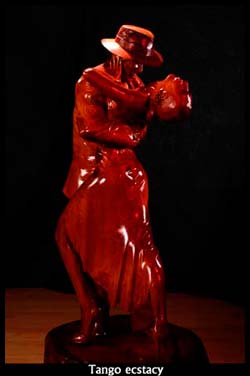By
Max Osorio, mexicano y tanguero

e was born in Mexico, in the Federal District. In 1985, after a large number of trips, art and bohemia drove him to Stowe, (Vermont, in the United States). There he succeeded in expanding his creativity until he became one of the most respected referents of the local sculpture. His artistic woodcarvings are sought after by the most highly regarded shops and residences in Stowe.
 Max Osorio is a sculptor who manages to make the magic of wood burst out in each piece he engraves. Even though his art output is vast and heterogeneous, the animals he has carved in all sizes and expressions are very interesting; and his tango sculptures are highly significant.
Max Osorio is a sculptor who manages to make the magic of wood burst out in each piece he engraves. Even though his art output is vast and heterogeneous, the animals he has carved in all sizes and expressions are very interesting; and his tango sculptures are highly significant.
Max has been able to carry the expression and mugging of dance and music to his plastic work. If Camille Claudel managed to capture the immense magic of dancing in The great waltz (La grande valse), a statue that is found at the Museo Soumaya in Mexico; Osorio by far succeeded in moving our hearts by means of his sculpture Tango, regularly exhibited at the Palais de Glace, Stowe (Vermont).
The art engravings of this great artist are not only concerned with dancing but also with star figures of our urban music. A work made as homage to Aníbal Troilo and his latest creation dedicated to the genius of Leopoldo Federico are examples of that. In sum, his sculptures create new spaces, unusual volumes and a different way of approaching the dos por cuatro (2x4).
Translator’s note: 2x4 is the time signature used in early tango, later it changed to 4x4.